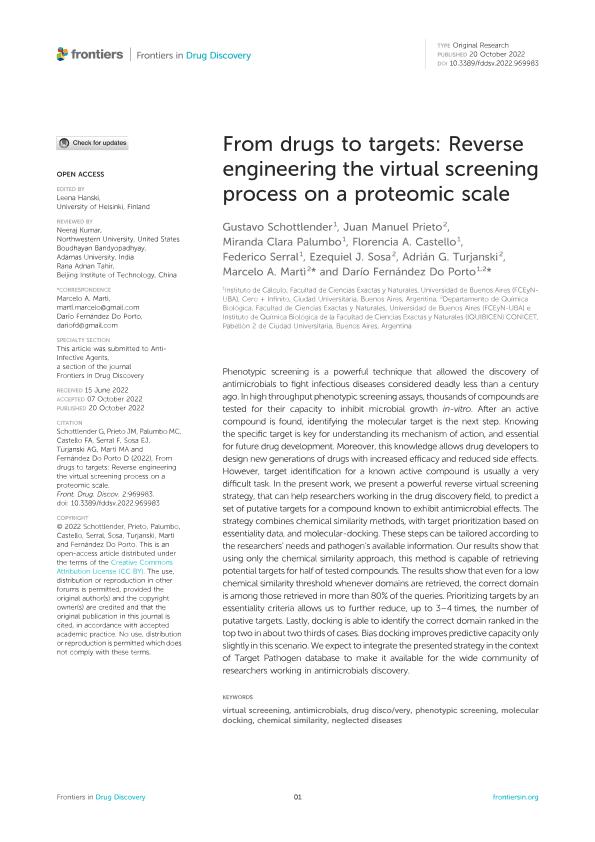Artículo
From drugs to targets: Reverse engineering the virtual screening process on a proteomic scale
Schottlender, Gustavo; Prieto, Juan Manuel; Palumbo, Miranda Clara; Castello, Florencia Andrea ; Serral, Federico
; Serral, Federico ; Sosa, Ezequiel
; Sosa, Ezequiel ; Turjanskiri, Adrián; Marti, Marcelo Adrian
; Turjanskiri, Adrián; Marti, Marcelo Adrian ; Fernández Do Porto, Darío Augusto
; Fernández Do Porto, Darío Augusto
 ; Serral, Federico
; Serral, Federico ; Sosa, Ezequiel
; Sosa, Ezequiel ; Turjanskiri, Adrián; Marti, Marcelo Adrian
; Turjanskiri, Adrián; Marti, Marcelo Adrian ; Fernández Do Porto, Darío Augusto
; Fernández Do Porto, Darío Augusto
Fecha de publicación:
10/2022
Editorial:
Frontiers Media
Revista:
Frontiers in Drug Discovery
e-ISSN:
2674-0338
Idioma:
Inglés
Tipo de recurso:
Artículo publicado
Clasificación temática:
Resumen
Phenotypic screening is a powerful technique that allowed the discovery of antimicrobials to fight infectious diseases considered deadly less than a century ago. In high throughput phenotypic screening assays, thousands of compounds are tested for their capacity to inhibit microbial growth in-vitro. After an active compound is found, identifying the molecular target is the next step. Knowing the specific target is key for understanding its mechanism of action, and essential for future drug development. Moreover, this knowledge allows drug developers to design new generations of drugs with increased efficacy and reduced side effects. However, target identification for a known active compound is usually a very difficult task. In the present work, we present a powerful reverse virtual screening strategy, that can help researchers working in the drug discovery field, to predict a set of putative targets for a compound known to exhibit antimicrobial effects. The strategy combines chemical similarity methods, with target prioritization based on essentiality data, and molecular-docking. These steps can be tailored according to the researchers? needs and pathogen?s available information. Our results show that using only the chemical similarity approach, this method is capable of retrieving potential targets for half of tested compounds. The results show that even for a low chemical similarity threshold whenever domains are retrieved, the correct domain is among those retrieved in more than 80% of the queries. Prioritizing targets by an essentiality criteria allows us to further reduce, up to 3?4 times, the number of putative targets. Lastly, docking is able to identify the correct domain ranked in the top two in about two thirds of cases. Bias docking improves predictive capacity only slightly in this scenario. We expect to integrate the presented strategy in the context of Target Pathogen database to make it available for the wide community of researchers working in antimicrobials discovery.
Archivos asociados
Licencia
Identificadores
Colecciones
Articulos (IC)
Articulos de INSTITUTO DE CALCULO
Articulos de INSTITUTO DE CALCULO
Citación
Schottlender, Gustavo; Prieto, Juan Manuel; Palumbo, Miranda Clara; Castello, Florencia Andrea; Serral, Federico; et al.; From drugs to targets: Reverse engineering the virtual screening process on a proteomic scale; Frontiers Media; Frontiers in Drug Discovery; 2; 969983; 10-2022; 1-14
Compartir
Altmétricas



